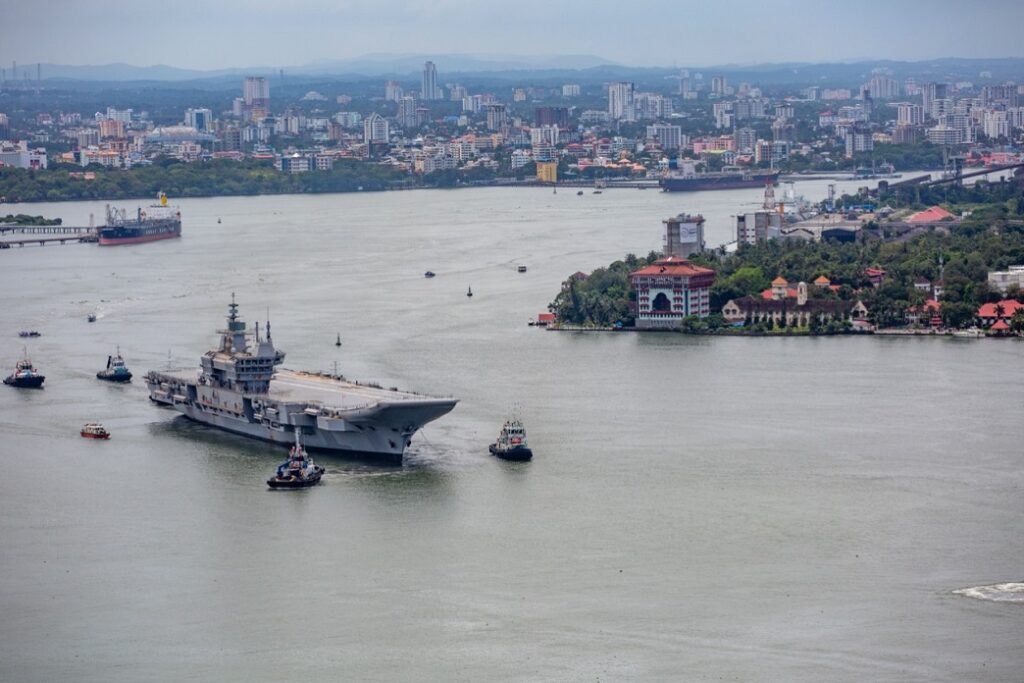Published on 08/04/2021 – Last Updated on 08/04/2021 by OTC
The Indian Navy announced on August 4 that the sea trials of its indigenous aircraft carrier, Vikrant, had begun.
The indigenous aircraft carrier (IAC) ‘Vikrant,’ designed by the Indian Navy’s Directorate of Naval Design (DND), is being constructed at Cochin Shipyard Limited (CSL), a Public Sector Shipyard under the Ministry of Shipping (MoS). With more than 76 percent indigenous content, IAC is a leading example of the nation’s quest for “Atma Nirbhar Bharat.” This is the Indian Navy’s and Cochin Shipyard’s first attempt to design and build an aircraft carrier from scratch.
The Indigenous Aircraft Carrier Vikrant has a length of 262 meters, a width of 62 meters, and a height of 59 meters including the superstructure. There are 14 decks in total, five of which are in the superstructure. The ship has over 2,300 compartments and is designed for a crew of approximately 1700 people, including specialized cabins for female officers. The ship has been designed with a high degree of automation for machinery operation, ship navigation, and survivability. ‘Vikrant’ has a top speed of around 28 knots and a cruising speed of 18 knots, with an endurance of approximately 7,500 nautical miles. The ship can accommodate a variety of fixed-wing and rotary-wing aircraft.
The majority of ship construction activities have been completed, and the ship is now in the trials phase. As part of the Basin Trials in November 20, the readiness of the ship’s propulsion and power generation equipment/systems was tested in port. During his visit to the ship on June 25, the Hon’ble Raksha Mantri reviewed the progress of the Carrier’s construction.
Though the start of sea trials was delayed due to the 2nd wave of COVID, the ship’s readiness for sea trials was achieved through the concentrated and dedicated efforts of a large number of workmen, OEMs, engineers, overseers, inspectors, designers, and the ship’s crew. This is a major milestone activity and historical event.
Reaching this milestone is significant because, with the exception of the current pandemic challenges and imponderables, they have all been achieved. The ship’s performance, including the hull, main propulsion, PGD, and auxiliary equipment, would be closely monitored during the maiden voyage.
With the delivery of Vikrant, India will join a select group of nations that have the capability to design and build an Aircraft Carrier in-house, which will be a true testament to the Indian Government’s “Make in India” thrust.

The indigenous construction of an aircraft carrier is a shining example of the country’s pursuit of ‘Atma Nirbhar Bharat’ and the ‘Make in India Initiative.’ This has resulted in an increase in indigenous design and construction capabilities, as well as the development of a large number of ancillary industries, with employment opportunities for 2000 CSL personnel and approximately 12000 ancillary industry employees.
In addition to work done by CSL and their subcontractors, over 76 percent of the equipment is procured with indigenous content. CSL has registered approximately 550 Indian firms, including approximately 100 MSMEs, who are providing various services for the construction of IAC.
The Indian Navy’s shipbuilding program is well-positioned to provide the necessary ‘Economic Stimulus,’ with 44 ships and submarines on order and being built in-house.
Check out Naval Library App to learn more about the specifications of INS Vikrant.
















Comments